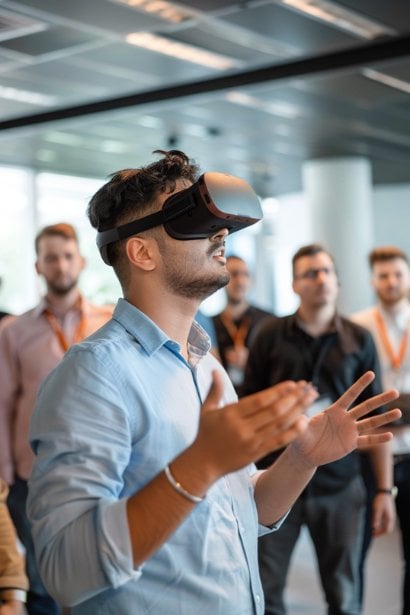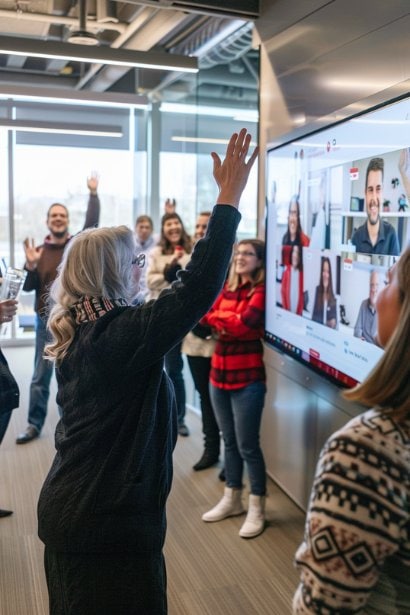Why Do Recruiters Use Virtual Interviews? [Unveiling the Strategic Advantages]

Virtual interviews have become an essential tool in the recruitment process. In the digital age, the speed and efficiency of hiring are crucial, and companies are turning to virtual interviews to streamline their hiring operations. These interviews offer a convenient platform for recruiters to engage with candidates without the constraints of location and time. By adopting this method, organizations can connect with a broader range of potential employees, enhancing their chances of finding the perfect match for their teams.
The integration of technology in recruiting has transformed how companies approach talent acquisition. Tools such as video conferencing software have made it possible to conduct interviews that once required face-to-face interaction through the internet. This technological shift not only saves time but also significantly cuts down on travel expenses for both recruiters and candidates. Furthermore, virtual interviews allow for a more flexible scheduling process, which is beneficial for candidates who may have other commitments or for recruiters looking to fill positions quickly.
Key Takeaways
- Virtual interviews provide a convenient and efficient hiring process.
- Technological advancements facilitate the conducting of interviews remotely.
- They offer a flexible scheduling option and potential cost savings.
Evolution of Recruitment
In examining the transformation of recruitment, you’ll find that advancements in technology have played a pivotal role. Traditionally, your recruitment process involved face-to-face interactions, with paper resumes and in-person interviews. But with the digital revolution, the scenario has shifted dramatically.

Technology Advances:
- Initial stages utilized email and job boards.
- Social media platforms became talent sourcing grounds.
- Recruitment software streamlined applicant tracking and management.
As technology advanced, you gained the tools to conduct video interviews and virtual assessments, which have become particularly crucial during the COVID-19 pandemic. The move to remote work during the pandemic necessitated a shift in the recruitment process.
Advantages of Virtual Interviews
Virtual interviews offer tangible benefits, from breaking down geographical limitations to enhancing time management and cost-effectiveness. You’ll likely find a substantial increase in efficiency and a more streamlined hiring process.

Reducing Geographical Barriers
With virtual interviews, you’re no longer constrained by physical distances. This expansion of boundaries allows you to:
- Interview candidates from different time zones without travel.
- Connect seamlessly regardless of where you or the candidates are located.
Time and Cost Efficiency
The virtual format of interviews is both time-saving and cost-effective. Key points include:
- Time-saving: Schedule and conduct interviews more quickly than traditional in-person meetings.
- Cost-saving: Save on resources by eliminating the need for physical space and travel reimbursement.
Wider Talent Pool Access
Access to a wider pool of candidates is a significant advantage. You can:
- Reach a diverse set of skills and experiences, untethered by location.
- Engage with candidates who may not have been accessible otherwise due to geographical constraints.
Streamlining the Hiring Process
Virtual interviews contribute to a more efficient hiring process by:
- Making scheduling easier and more flexible for both interviewers and candidates.
- Allowing for quick follow-ups and second interviews, speeding up decision-making.
| Advantage | Description |
|---|---|
| Convenience and Efficiency | Enables quick scheduling and conducting of interviews, removing geographical and time constraints. |
| Cost Savings | Reduces or eliminates travel expenses and the need for physical space, leading to significant savings for both recruiters and candidates. |
| Wider Talent Pool | Allows access to candidates from various locations, increasing diversity and the chance of finding the best match. |
| Flexible Scheduling | Accommodates candidates’ and recruiters’ availability more easily, speeding up the hiring process. |
| Technological Integration | Utilizes video conferencing and applicant tracking systems to streamline the recruitment process. |
Technology in Virtual Recruiting
Your understanding of how technology defines contemporary virtual recruiting is crucial. You’ll find that video interview software, applicant tracking systems, and AI contribute significantly to the efficiency and effectiveness of the hiring process.

Role of Video Interview Software
Video interview software is vital for conducting real-time interviews and pre-recorded questionnaires. Zoom and Skype are common platforms you may be familiar with that allow candidates to connect with recruiters from any location. This software typically offers features such as interview scheduling, automated reminders, and recording capabilities to facilitate a seamless interview process.
Integration with Applicant Tracking Systems
Applicant Tracking Systems (ATS) are a cornerstone in recruitment technology. They efficiently organize and filter candidate information and resumes. ATS solutions can seamlessly integrate with video interviewing software, thus streamlining the interview process. This integration allows you to track candidates through every stage of recruiting, from initial contact to hiring, all within a single system.
AI in Recruitment
Artificial Intelligence is transforming recruitment by automating repetitive tasks and enhancing decision-making. AI-powered interview software can analyze candidates’ responses and nonverbal cues for better insights. Online assessment platforms leverage AI to score tests objectively. AI in candidate sourcing tools and HR management software significantly reduces your manual workload and improves hiring quality.
Challenges of Virtual Interviews
Virtual interviews present unique challenges that can affect both the interviewer and the interviewee. These challenges can impact communication, evaluation of non-verbal cues, and the establishment of a personal connection.

Technical Issues
Your experience during virtual interviews can be significantly affected by technical difficulties. An unstable internet connection may lead to interruptions, resulting in a disjointed conversation and potential misunderstandings. Preparedness with a reliable setup is crucial, as hardware or software failures can lead to delays or cancellations.
- Examples of Technical Issues:
- Internet outages or slow speeds.
- Hardware malfunctions (broken headphones, webcam issues).
- Software problems (incompatible versions, application errors).
Maintaining Personal Connection
The remote environment of a virtual interview can make it challenging to foster a strong personal connection. Without the benefit of a shared physical space, creating rapport relies heavily on verbal communication. You must adapt your communication style to convey enthusiasm and professionalism through a screen.
- Tips for Better Connection:
- Articulate clearly and maintain eye contact by looking at the camera.
- Show engagement through nods and verbal acknowledgments.
Assessing Non-Verbal Cues
Evaluating an interviewee’s body language and non-verbal cues is more difficult through a screen. Subtle gestures or expressions may go unnoticed or be misinterpreted. As an interviewer, it’s important to be aware of these limitations and adjust your assessment criteria accordingly.
- Key Non-verbal Cues to Observe:
- Posture and gestures that indicate confidence or nervousness.
- Facial expressions that can offer insight into the interviewee’s reactions.
Best Practices in Virtual Interviewing
Successful virtual interviews rely on a blend of technology, planning, and interpersonal skills to sustain a professional and equitable hiring process. These practices ensure you can assess candidates effectively while providing them with a fair and engaging experience.

Creating a Professional Environment
Your Setup: Ensure your video-conferencing technology is functioning properly before the interview. Light your space evenly and choose a clean, distraction-free background. It’s imperative to dress professionally, as it sets the tone for the interview and reflects your company’s culture.
Candidate’s Space: Inform candidates in advance about the ideal setup, encouraging them to find a quiet, well-lit place. This ensures they can focus on the interview without distractions, contributing to a professional environment and a positive candidate experience.
Fostering Engagement and Fairness
Engagement: Utilize video-conferencing features, like screen sharing or virtual whiteboarding, to create interactive discussions. Keep eye contact through the camera and nod or smile when appropriate to foster engagement. Structured questions also help to maintain a clear, focused conversation.
Fairness: Apply consistent criteria for all candidates to ensure legal compliance and fairness. This includes using the same questions and similar interview duration for each individual. Explain your virtual interview process upfront, setting clear expectations for a smooth and transparent experience.
Handling Remote Work Dynamics
Remote Teams: If the role is remote, discuss the dynamics of existing remote teams. Explain how communication and collaboration occur within your company, emphasizing the importance of being proactive and self-motivated in a remote setting.
Technology’s Role: Familiarize candidates with the video-conferencing tools your team uses. You can even include a brief tutorial at the start of the interview, demonstrating key features to alleviate any potential technical issues and to ensure a seamless candidate experience.
Impact on Corporate Culture
The adoption of virtual interviews by recruiters significantly shapes your company culture, affecting inclusivity and the process of enculturation in a modern corporate setting.

Inclusivity and Diversity in Recruiting
Your commitment to inclusivity and diversity in talent acquisition is demonstrated through the use of video interviewing tools. These tools can:
| Impact on Inclusivity and Diversity | Description |
|---|---|
| Break Geographical Barriers | Connect with candidates globally, enriching the mix of cultural backgrounds in the talent pool. |
| Reduce Unconscious Bias | Use structured interview formats to provide a consistent experience for all candidates, promoting fairness. |
| Accommodate Different Needs | Consider applicants with physical disabilities by offering them an equal opportunity to participate. |
Enculturation in a Virtual Setting
The challenge in a virtual environment is maintaining your engagement with new hires to immerse them in the company culture effectively. Strategies include:
- Virtual meet-and-greet sessions: These allow new hires to interact with teams and learn about company norms.
- Shared digital spaces: Encourage interaction and collaboration, simulating a communal office experience.
- DEI (Diversity, Equity, and Inclusion) training: Online workshops can align new recruits with your core values from the outset.
Future Trends in Virtual Recruitment
Virtual recruitment technologies and strategies continue to transform the hiring process. Here’s what you need to look out for:
Ongoing Technological Evolution
Virtual interviews have become integral to your recruiting process, thanks in part to platforms like HireVue. These services offer assessment tools that enable you to get a comprehensive view of a candidate’s skills and potential fit. As technology evolves, you can expect more sophisticated artificial intelligence (AI) and machine learning tools to provide deeper insights into applicants’ abilities. For example, AI can analyze facial expressions and speech patterns to assess personality traits and communication styles.
Furthermore, you’ll likely see an expansion of virtual reality (VR) and augmented reality (AR) in interviews. This could involve simulations where candidates demonstrate their skills in a controlled, virtual environment that closely mimics real-world scenarios. These technologies could also help in reducing the environmental impact of recruitment, as they negate the need for travel.

Rise of On-Demand Interviews
On-demand interviews are poised to meet the needs for efficiency in filling job openings. Forbes has highlighted the convenience and scalability of such methods. Candidates can record responses to set questions at their convenience, and you can review these submissions at your own pace. This method offers flexibility and reduces scheduling conflicts between you and the candidate.
Expect to see more integration with mobile devices, as job seekers increasingly rely on smartphones for job searches and application processes. Your recruitment strategy would benefit from aligning with this mobile-first approach. On-demand interviews via mobile platforms can make the application process more accessible, thereby widening your talent pool and improving the chances of finding the right fit for your job openings.
Conclusion
Recruiters have embraced virtual interviews as a mainstay in the recruitment process. You have seen that these interviews streamline the hiring phase, allowing both recruiters and hiring managers to efficiently evaluate candidates from diverse geographical areas, leading to expanded candidate pools. This is particularly significant in a globalized job market.
Utilizing video interviewing software enhances consistency and reduces bias, as all candidates answer the same questions. As you consider this, remember that these benefits are not only for recruiters but also for you as a candidate. The convenience offered by on-demand video interviews is considerable, allowing you to participate from any location without the stress of travel.
HR tech advancements ensure that live video interviews are accessible and user-friendly. This makes your interaction with companies smooth and direct, allowing both ends to focus on the content rather than logistics. The virtual interview process also speeds up the time-to-hire, which is a positive outcome for you, keen on starting a new role, and for hiring managers, who are eager to fill vacancies.
Finally, consider that although there may be concerns regarding impersonality or technical issues, the overall gains like reduced time and cost for both you and the organization, and the ability to quickly adapt to high turnover, underscore why the practice of virtual job interviews has become integral to modern recruitment.






